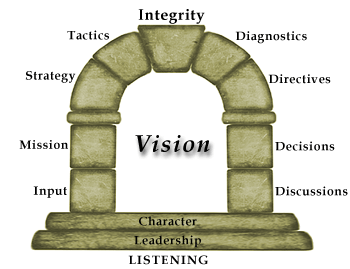Integrity Arch...by
James F. Bracher, architect for the renewal of integrity-centered
leadership
 Listening
Listening
Listening is the art of moving beyond one's need to control
the agenda. Listening creates a conversational context
for give-and-take that prospers when inquiring supersedes
influence. Listening seeks clarity and expedites insight.
Listening creates partnership and commitment. Listening
is the key for organizational effectiveness and leadership.
Leadership
Leadership rallies resources to achieve objectives. Those
who exhibit integrity-centered leadership leverage talent
with decision-making courage and tenacious follow-through.
They affect organizational productivity. Leaders listen,
process and evaluate data, take action, and then solicit
feedback to refine future efforts. Leaders continuously
improve. Leaders adhere to culture, commitments, promises
and rules. They are honest and reasonable not because
of any external force, but rather because of their own
internal drive to sustain organizational values.
Character
Character is the ability to carry out the resolution long
after the initial burst of enthusiasm is gone. Character
shows when decisions are implemented. Character is demonstrated
by how one facilitates discussions, takes decisions, administers
directions and implements diagnostics. Character is the
sum total of behaviors and is most completely demonstrated
when individuals perform under pressure. Graciousness
is almost always part of effective leadership character.
Leaders with character drive organizational culture in
all actions.
Input informs Discussions
Vision, the destination of an enterprise, is achieved
when leaders encourage input through discussions. Leaders
weigh efficiency and effectiveness on the scale of openness,
honesty, trust, care and vulnerability. Leaders listen.
Mission drives Decisions
With input shaping discussions, leaders measure decisions
alongside the mission of the organization. Staying focused
often has more to do with success than either genius or
exhaustive research. Leaders recognize the costs and consequences
of decisions. They measure progress against mission-critical
achievements. Leaders seek a proper balance between self-interest
and social responsibility. Leaders decide.
Strategy prioritizes Directives
Leaders know that strategy energizes directives. Guiding
associates effectively necessitates constancy and consistency
with reference to planning the work and working the plan.
Casual abdication of principles in rough weather breeds
contempt among followers and glee from competitors. Setting
priorities based upon a substantive strategy reassures
the workforce and compounds the efforts that underpin
success. Leaders are steady.
Tactics require Diagnostics
Tactics bring organizations closest to the customer. Relentless
measurements, continuously seeking improvement, enhance
successful performance. Diagnostics monitor transactions
and assist with customer service and product refinements.
Leaders pursue perfection.
 Integrity
is the Keystone
Integrity
is the Keystone
Integrity is congruence between what you say and what
you do, as well as what you say about what you did. Integrity
is the keystone of leadership. The keystone holds the
enterprise together at its most critical junction, where
ideas, products and services meet the customer. The keystone
enables the arch to fulfill its supportive mission. Integrity
enables an organization to achieve its mission. Integrity
is the strength, unity, clarity and purpose that upholds
and sustains all of the activities of the enterprise.
Integrity provides this stabilizing dimension by never,
ever, compromising. Integrity recognizes risks and assumes
responsibility. It drives the realization of vision toward
the enterprise's destination. Leaders exude integrity.
Eight Attributes
of an Integrity-Centered Company
by
James F. Bracher, architect for the renewal of integrity-centered
leadership
1.
CHARACTER: consistency between word and deed.
Do the leaders of your organization exhibit congruence between what they say
and what they do, as well as what they say about what they did? Do leaders
exhibit the right behavior?
2. HONESTY: truthful
communication.
Do you have confidence that your leaders would never engage in or sanction
misrepresentation?
3. OPENNESS: operational
transparency.
Is appropriate information about your organization readily available?
4. AUTHORITY: employee
encouragement.
Are you able to correct a customer problem? Do you have confidence that your
actions will be supported?
5. PARTNERSHIP: honor
obligations.
Does your organization pride itself on timely fulfillment of all commitments?
6. PERFORMANCE: accountability
throughout the organization.
When individuals, including senior executives, under-perform repeatedly, are
they given due process and then, if necessary, replaced?
7. CHARITY: generous
community stewardship.
Does your organization reach out to those in need?
8. GRACIOUSNESS: respect
and discipline.
Does your organization demonstrate care and concern for all stakeholders?
Vision identifies Destination
Vision is where one is going. Vision draws us to our
destination individually and organizationally. Integrity
secures the arch along our pathway to increased productivity.
Home Page | About
Us | Ask Bracher | Services
| Resources | Contact
Us